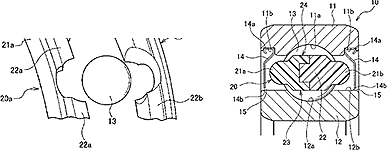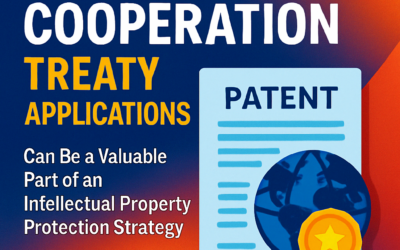It is important when responding to an obviousness type claim rejection in an office action that an inventor doesn’t fail to raise any reasonable good faith arguments. Since patent examiners are human, you never know what argument a particular examiner might think is persuasive and what arguments he might completely dismiss – even though the argument seemed like a homerun. Therefore, the more reasonable good faith arguments that can be made, the greater chance there is of overcoming an obviousness type claim rejection. One particularly persuasive argument, if the inventor is able convince the examiner of it, is that the suggested modification to the prior art patent reference used in the obviousness claim rejection would render the cited prior art invention unsatisfactory for its intended purpose.
After a patent application is properly submitted to the United States Patent and Trademark Office (“USPTO”), it undergoes an examination. One of the hurdles that must be overcome in order for the potential patent to be allowed is an obviousness assessment. An obviousness rejection occurs when the examiner determines that it would be obvious to modify a prior art reference to form the inventor’s claimed invention. For example, a typical obviousness rejection looks like the following: prior art reference A discloses all but a single element of inventor’s claimed invention and prior art reference B discloses the element not disclosed by prior art reference A, therefore, it would be obvious to modify A to incorporate the element of B.
When encountering an obviousness rejection, there are many statutory and judge made arguments that can be used to try and overcome the rejection. One of the most persuasive arguments to overcome an obviousness rejection is to convince the examiner that the suggested modification would render the prior art reference unsatisfactory for its intended purpose. If a proposed modification would render the prior art invention being modified unsatisfactory for its intended purpose, then there is no suggestion or motivation to make the proposed modification. In re Gordon, 733 F.2d 900, 221 USPQ 1125 (Fed. Cir. 1984). As such, if the Examiner agrees with the inventor’s arguments that the suggested modification would make the prior art unsatisfactory for its intended purpose then the examiner will withdraw the obviousness rejection.
A basic example of this is if the inventor submitted a patent application disclosing and claiming a game ball with spiked protrusions on its surface (perhaps for use in a demolition derby), and, the examiner rejected the claims by citing to prior art reference A, which discloses a customary, smooth soccer ball, and prior art reference B, that discloses a different type of ball (such as that used for a medieval flail) that has spiked protrusions on its surface, and, therefore, concludes that it would be obvious for one skilled in the art to modify a soccer ball to have spiked protrusions on its surface. Given the above rejection, the inventor could then argue that modifying a smooth soccer ball to have spiked protrusions on its surface would render the soccer ball unsatisfactory for its intended purpose. The intended purpose being the creating of a ball that can be used in a traditional soccer game. Since a ball with spiked protrusions over its surface would not roll or bounce straight, as well as hurt anyone who tried to kick or head-butt it, it would make a customary soccer ball unsatisfactory for its intended purpose of being used in a traditional soccer game.

To escape out of the imaginary realm, a real-life example is shown to the right where the inventor’s claims were directed to a one-piece roller bearing cage.
Roller bodies are freely inserted into the pockets 3 of Applicant’s roller bearing 1 without obstruction. To prevent the roller bodies from falling through the cage 1, the pockets 3 of the cage 1 have inwardly tapered shoulders 5 which narrow the diameter of the pockets 3.
Applicant’s claims were rejected by the Examiner based on JP 2009-275799 A (“the ‘799 reference”), shown below.

As can be seen from the figures above, the pillar sections 22a, 22b of the ‘799 reference’s cage 20 have a “curvature radius” that forms a “partially spherical pocket[.]” (The ‘799 reference specification, paragraph [0015]). The curvature of radius enables the cage 20 disclosed in the ‘799 reference to completely secure the roller bodies 13 in all directions when the two pieces of the cage 21a, 21b are connected around a roller body 13. To overcome the ‘799 rejection, it was argued that modifying the ‘799 reference to be a one-piece cage would render the ‘799 reference unsatisfactory for its intended purpose of holding and securing roller bodies. It was argued that if the ‘799 reference were a one-piece cage, roller bodies would not be able to be placed in its pockets due to the curvature of radius making the diameter at both axial ends of the pockets less than the maximum diameter of the roller bodies. Said another way, the ‘799 reference’s purpose of securing a roller body in all three directions when the two pieces of the cage are connected around a roller body would prevent insertion of roller bodies into the pockets of the cage if the cage were manufactured as a single piece.
While the unsatisfactory argument is specifically for overcoming obviousness rejections, it can be very beneficial to argue the unsatisfactory argument in anticipation rejections as well. It is beneficial for two reasons: it can help bolster the arguments used to overcome an anticipation rejection, and, it can prevent a future obviousness rejection. If an examiner is not fully convinced that the inventor’s argument in response to an anticipation rejection is persuasive enough to overcome the rejection, the examiner may be unquestionably convinced if the inventor further argues that not only is his claimed invention not anticipated by the prior art reference, but, it is also not obvious to modify the prior art reference. In addition, making the unsatisfactory for its intended purpose argument in response to an anticipation rejection may prevent future obviousness rejections. The logical progression for an examiner after the inventor overcomes an anticipation rejection is to turn the prior art reference used in the anticipation rejection into the base reference for an obviousness rejection. Therefore, using an obviousness argument in the anticipation stage can prevent the examiner from using that prior art reference in a future obviousness rejection.
In conclusion, to overcome an obviousness rejection on grounds that the modified prior art reference is unsatisfactory for its intended use, an inventor must first determine the purpose of the prior art reference being modified. Keep in mind that a prior art reference may have more than one purpose. Subsequently, the inventor must argue why modifying the prior art reference to form inventor’s claimed invention would render the prior art reference incapable of performing its identified purpose. In addition, it is recommended to use this argument, if applicable, in anticipation rejections as well in order to avoid future obviousness rejections and to bolster inventor’s arguments against the claimed invention being anticipated by the prior art relied on by the examiner.
If you have any questions regarding: responding to patent office actions, prosecuting your patent application, conducting interviews with patent examiners, branding, trademarks, patent planning or other intellectual property matters, please contact Garcia-Zamor Intellectual Property Law, LLC







